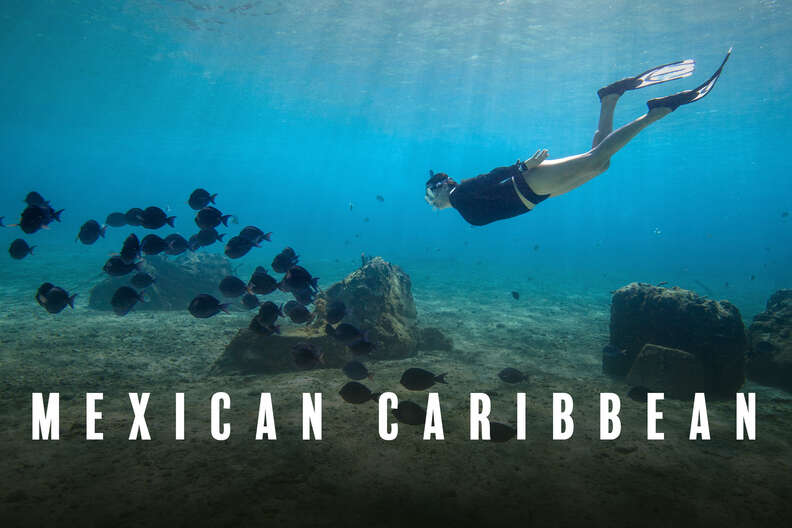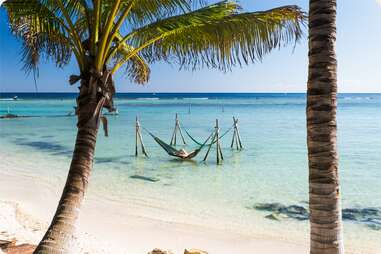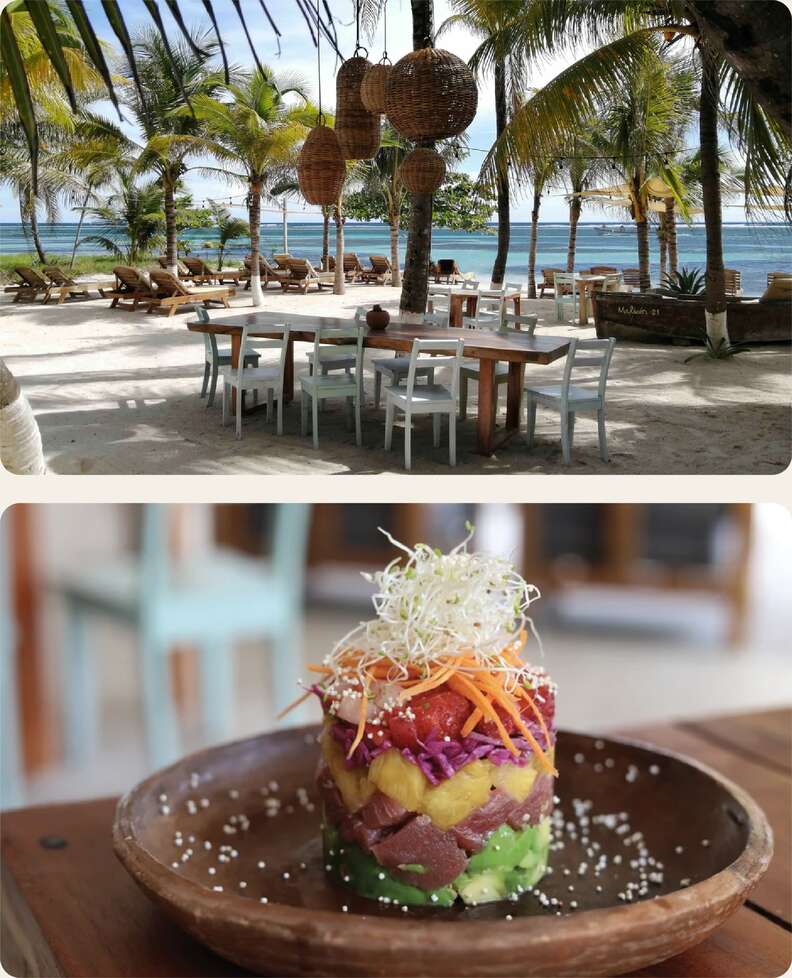
A Port-by-Port Guide to the Mexican Caribbean’s Many Treasures
This slice of Mexican paradise is calling out for you to explore it. Here's how to make the most of your journey.
Mezcal and mangroves. Cenotes and centuries-old ruins. Vacationing in the Mexican Caribbean is the gift that keeps on giving. Along this enchanting corridor is a destination known as Grand Costa Maya, once Mexico’s best-kept secret that’s not so secret anymore. The region comprises Chetumal, Mahahual, and Bacalar—each a spot with its own unique vibe and history.
Chetumal is the capital of Quintana Roo but it tends to be unfairly overlooked in favor of better-known destinations in the state like Playa del Carmen, Cancún, and Instagram-friendly Tulum.
Mahahual (also spelled “Majahual”) is home to UNESCO-protected watery wonders and a purpose-built Disneyland of sorts where visitors are treated to a smorgasbord of natural, cultural, and culinary temptations.
If Mahahual is a hidden gem, Bacalar is the treasure at the end of the rainbow. The town’s pride and joy is the Lagoon of Seven Colors which is a dreamscape of various hues of blue and green. Then there’s Cozumel, an island known for sacred Mayan worship sites shrouded in lore and a reputation for diving and snorkeling that makes it a highlight of the legendary Mesoamerican Barrier Reef.
These slices of Mexican paradise offer tastes of old and new—from Indigenous rituals and vibey beach bars to unparalleled water sports and places that look like someone threw an Instagram filter over reality. This is a corner of the globe calling out for you to explore it.
Your trip isn’t complete until you...
See: The Voladores de Papantla (Papantla Flyers) at the center of the Costa Maya cruise port square. This is an ancient rain-invoking ritual where a group of men dressed in vivid hues of red and white spin through the air around a towering pole while one stands atop playing the flute.
Touch: A snorkel mask as you dip into the Mesoamerican Barrier Reef to spot blue tangs, sergeant majors, and turtles.
Smell: Delectable and fragrant pescadito frito (fried fish) being freshly prepared at San Carlos Pescadaria in Cozumel, Los Aluxes Bacalar, or Beach Bums Costa Maya in Mahahual.
Hear: The water splash as you jump into Bacalar’s Lagoon of Seven Colors.
Taste: Cochinita pibil and tacos al pastor. Pibil refers to the ancient method of cooking in a pib, a traditional Mayan oven, which is essentially a hole in the ground lined with hot stones. The name “cochinita” refers to a tiny pig, and the dish is a slow-roasted, deeply flavored pork nestled inside a taco or stuffed into tortas.
Tacos al pastor is a popular Mexican dish made from thin slices of marinated pork, cooked on a vertical spit, then topped with fresh cilantro, chopped onions, and pineapple. Some of the best street food spots to try these juicy delicacies don’t even have names, much less websites or social media accounts.

Things to do in Mahahual
Less than two hours from Chetumal and tucked within the Costa Maya, Mahahual straddles two worlds: on one side, you have the bustling cruise port area; on the other, a laid-back enclave that still holds onto its fishing village soul despite the influx of day-trippers.
The port area offers amusement rides, bird aviaries, and souvenir shops that were explicitly designed to keep cruisers entertained within arm’s reach of their ships. Those wishing to explore further afield may head out on sea turtle snorkeling escapades, dive among kaleidoscopic reefs, laze on beaches with water so clear you can see your toes wiggle, or wander the waterfront promenade (malecón) that’s lined with local joints slinging cold coconuts and fresh seafood. And when craving history, there are Mayan ruins like Chacchoben (known as the “Place of Red Corn”) just a short drive away.

Morning – Explore the biodiversity at the Banco Chinchorro Biosphere Reserve. About 30 kilometers off Mahahual’s coast, UNESCO-listed Banco Chinchorro is Mexico’s largest atoll and one of its most secluded marine reserves. Spanning over 144,866 hectares of untouched water, mangroves, sandy beaches, and vibrant coral reefs, this place feels like the wild frontier of the Yucatán. It is known for its black coral, swarms of tropical fish, nurse sharks, and saltwater crocodiles hidden in the mangroves.
Noon – Feast on beachfront lobster at Chunky Monkey Beach Club. After working up an appetite underwater, make your way to this bright, personality-drenched spot. This restaurant gives you that barefoot, off-the-grid feeling that vacation is all about. Seafood staples like ceviche, shrimp tostadas, and grilled octopus are among the menu’s highlights, but you’ll never go wrong with the oh-so-juicy lobster.

Afternoon – Tour a pair of Mayan ruins. The Chacchoben ruins, the “Place of Red Corn,” sit quietly cloaked in the jungle about an hour’s drive from Mahahual and the cruise port at Costa Maya. Though the site is not as famous as Tulum’s beachfront ruins or Chichen Itza, this maze of pyramid-shaped temples and stone steps is very much worth the trip. Don’t miss the elevated Gran Basamento—once the heart of Mayan ritual life—where priests are believed to have held ceremonies while spider monkeys watched from the trees above.
A five-minute drive away, Oxtankah tells a story of Maya ingenuity that goes beyond the familiar feats of astronomy and pyramids. You’ll find remnants of over 100 buildings from the ancient city’s peak between 200 and 600 AD, and while much of the site remains untouched by excavation, it hints at a civilization that was as commercial and resourceful as it was spiritual. Oxtankah’s name, given by 20th-century researchers, could mean “place surrounded by Ramón trees” or “three neighborhoods.”
Evening – Wind down for the day at Malecon21. Toast to a day well spent at this beach club and restaurant with a boho chic aesthetic and lanterns that look like bird nests swinging in the breeze. Massages on the sand? They’ve got those too. Beach club access here comes in tiers. With the entry-level rate, you get a beach bed, Wi-Fi, and a food-and-drink credit. Go big with the platinum package and you’re looking at unlimited drinks, lobster on the menu, and a beach bed that’s yours until closing time (10:30 pm).

Things to do in Cozumel
Cozumel is Mexico’s largest inhabited island. This land was sacred ground to the ancient Mayans as the home of the sun deity Itzámna and his wife Ix-Chel who, according to legend, gifted the island with the graceful swallow. The symbol of this bird now graces everything from murals to market trinkets that you can pick up in San Miguel, Cozumel’s main town.
Today, Cozumel’s real gift is its reef—an underwater explorer’s dream within the Mesoamerican Barrier Reef, the largest in the Western Hemisphere and second only to Australia’s Great Barrier Reef in size. This is an ideal pit stop whether you're just learning to breathe through a snorkel or you’re an old hand at deep-sea dives. There is no shortage of tour operators and dive shops ready and willing to whisk you away to meet over 200 marine species including scorpion fish, tangs, seahorses, and drum fish with their zebra-like stripes, and you’ll find many of them within walking distance of Cozumel’s cruise port.
The sweet underwater views might be the star attraction, but Cozumel isn’t lacking in land-based beauty either. Ten miles wide and 29 miles long, the island brims with unspoiled beaches sprinkled alongside ruins and museums. And if you poke around, you’ll find some surprisingly enticing international cuisine thanks to the melting pot of people passing through. Cozumel’s got a little something for everyone, even if you’ve only got a few hours to soak it in.

Morning – Explore the Cozumel Museum. This museum dates back to the 1930s and it’s a 15-minute drive from the Puerta Maya cruise center. Go to check out the permanent and temporary exhibits that detail the island’s history and varied ecosystems in a recently renovated former luxury hotel.
The museum is self-paced and bilingual with explanations in Spanish and English. No matter how tempting, do resist the urge to dip your fingers into the vintage box of Yucatan chewing gum on display. Also, if you happen to have large or heavy bags with you, the staff can store them at the front desk if you’d rather not schlep them around.
Noon – Find your way to heaven for diving and snorkeling (El Cielo). El Cielo, which translates to “the sky” or “heaven” is a little slice of underwater paradise that’s part of the sprawling Mesoamerican Reef. Here, the visibility for peeking at starfish dotting the sea bed is near perfect and the waters hold a year-round warmth that ranges between 78°F and 82°F. You can join a tour to El Cielo right from the San Miguel ports and they’re usually an all-inclusive experience including your gear, lunch, and the boat ride itself.

Afternoon – Fraternize with flamingos, egrets, and crocodiles at Punta Sur Eco Beach Park. There might also be iguanas basking in the sun, turtles cruising the lagoon, and even the occasional crocodile eyeing you from afar at this nature reserve spanning over 1,000 hectares. You can climb Faro Celerain lighthouse for a panoramic view that stretches over land and sea, take a boat ride through the Columbia Lagoon, or just chill out on the pristine white-sand beach lapped by turquoise waters. Park admission costs $22 and it’s open Monday to Saturday until 5 pm. There’s little in the way of shade in these parts so don’t forget a sun hat and stay hydrated if you’ll be tackling the 133 steps at the lighthouse.
Evening – Live music at The Money Bar Beach Club. Perched on the edge of the Dzul-Ha Reef on the west of the island (facing Playa del Carmen), this Cozumel institution with swing seats pleases its lively crowd with live music and it is particularly vibey just before those magical sunset hours. There is a rotating cast of singers and bands offering audio therapy in the form of Latin, pop, and rock songs. Order the Money Bar Special.

Things to do in Bacalar
Founded as a Mayan village in 435 AD and later renamed Villa de Salamanca de Bacalar by Spanish settlers, Bacalar is steeped in culture and history. It may have been sacked by pirates before a fort was built to successfully defend it, but today, it’s one of Mexico’s most tranquil and breathtaking destinations. The undeniable headliner of Bacalar is the Lagoon of Seven Colors (Laguna de Los Siete Colores), a shimmering expanse of water that morphs from deep indigo to shades of turquoise and jade depending on the sunlight and water depth.
Stretching almost 60 kilometers long, it’s Mexico’s second longest lagoon after Chapala’s and it’s a picturesque playground for water lovers offering everything from kayaking and jet skiing to tranquil boat rides. For those with a passion for science and nature, it’s home to some of the most ancient fossils on the planet: stromatolites. These rock formations are 350 million years old and make Bacalar a geological wonder in addition to its status as a visual marvel. Getting there from Mahahual is probably best undertaken as part of a tour you purchase online or arrange with an on-the-ground tour operator.

Morning – Swim in a cenote. Cenotes are mysterious, water-filled sinkholes that dot the Yucatán Peninsula and they were believed to be portals to the underworld by the ancient Maya. The cenotes of Bacalar are all wide open, sun-drenched natural playgrounds, not the typical stalactite and stalagmite-having caves.
At Cenote Esmeralda, the dark blue waters reach a dizzying 70 meters in depth and visitors fawn over the "eye" where the cenote meets the Laguna. Cenote Cocalitos is where you’ll find a sanctuary of stromatolites—ancient, bacterial rock formations that look like something straight out of an alien landscape. Snorkel, kayak, swim, or simply sway in one of the many swings or hammocks placed in its gin-clear waters.

Afternoon – Treat yourself to a pre-Hispanic ritual. Pop over to eco-friendly boutique hotel Casa Hormiga for a pre-Hispanic earth, water, fire, and ether ritual at its on-site Casa Ritual spa. Your chosen session may even be determined by your zodiac sign. One covetable experience there is a visit inside the temazcal, an igloo-shaped sweat lodge where heat, steam, and ancestral wisdom intertwine to guide you back to yourself.
Evening – Tap into the creative scene of Bacalar Town. Stroll around the streets which come alive with murals of Maya warriors, jaguars, and tropical birds then grab light refreshments at Vincent Van Gogh-inspired Café Tito Bacalar in Zócalo. Afterward, head to El Manati to catch some live music. or browse local crafts. This place is part restaurant, part boutique, part art gallery, and all charm.

What to know before you go
The currency
The Mexican peso (MXN) is legal tender throughout the country. You’ll need pesos in your pocket if you want to buy street food, give cash tips, or pay for things at local markets though US dollars are accepted in tourist-heavy areas. At the time of writing, $1 USD gets you 19.98 pesos. You can withdraw pesos from the ATMs at the Costa Maya cruise terminal.
International adapters you’ll need
To power up your gadgets in Mexico, you’ll use the same Type A and Type B plugs you’ll find in the US and Canada. Type A is your standard two-flat-pin setup while Type B adds a round grounding pin to keep things stable. The voltage there runs at 127 V with a frequency of 60 Hz.
When to plan your visit
Hurricane season in the Mexican Caribbean runs from June to November and the beaches can be invaded by pesky sargassum seaweed from April to October.
If you're lucky enough to be in Cozumel for Día de Muertos on the first and second day of November, expect to see the streets hum with life as catrinas—those iconic skeletal figures—are everywhere you turn, and papel picado banners flutter in the breeze. The biggest event of the year on the island is the Cozumel Carnival in February. To swim alongside magnificent whale sharks in Cozumel, mark your calendar for between mid-May and mid-September.
A noteworthy cultural event in Bacalar worthy of bookmarking is La Feria de San Joaquín, which is held every August. There, you can witness art exhibitions, folkloric dance, fancy festive attire, and fireworks over nine days.
Do’s and don’ts when visiting the Mexican Caribbean
Do bring reef-safe sunscreen if you plan to snorkel or dive. It’s all that’s allowed at places like Cozumel’s Chankanaab Park. Products with ingredients including oxybenzone, octinoxate, and 4-methyl benzylidene camphor are banned there due to their negative impact on marine ecosystems. Sunscreen brands like Coral Safe, All Good, Raw Love, Suntegrity, and Kokua Sun Care will have you covered (literally).
Do take the opportunity to try street food and support the communities you visit by making purchases from local vendors or mom-and-pop eateries where possible.
Don’t drink tap water under any circumstances. Opt for purified or bottled water to stay hydrated without any unwanted stomach issues. This does not mean you have to avoid on-shore cocktails or cold drinks from restaurants, as the ice cubes are made with filtered water.
Don’t litter on beaches. Keep them the way you found them and don’t ignore the color-coded beach warning flags that signal whether it's safe to swim. Green means you’re good to go, proceed with caution if there’s a yellow flag, red indicates dangerous waters ahead, and a black flag is a firm no-go.
Finally, resist the urge to touch any sea life or snag a piece of coral for your coffee table back home. Look but don’t touch is the rule of thumb for all undersea activity.
Your fun Mexican Caribbean dinner party fact
You’ll impress your friends by informing them that Cozumel is the only place in the world where you can find eight-finned sanopus splendidus aka the splendid toadfish. Also, during the Mayan civilization, single and pregnant women from as far as present-day Honduras and Belize would travel to Cozumel to pray to Ix-Chel, the goddess of womanly crafts.
